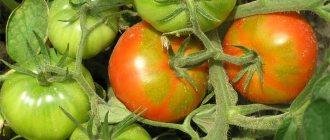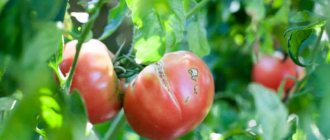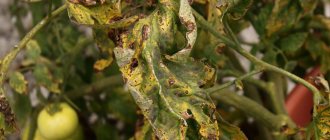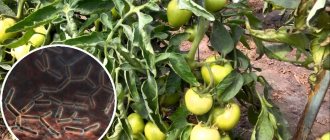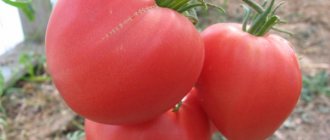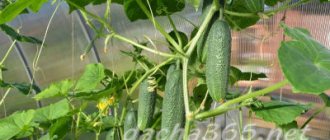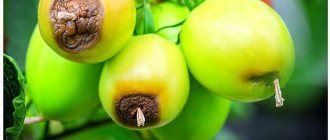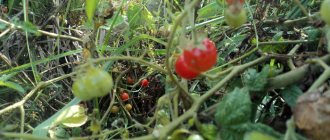Many gardeners grow tomatoes in a greenhouse, in which pollination by wind and insects is problematic and it is worth taking care of this yourself. In this article we will look at how to pollinate tomatoes in a greenhouse using natural and artificial methods and why to do it.
Even if you chose the right variety, took care of a good greenhouse and made high-quality soil, this does not guarantee an excellent harvest. One of the harvest factors is pollination - this is a minor disadvantage of greenhouses.
Why pollinate tomatoes in a greenhouse?
Fruit formation occurs only after pollination. Plants are usually divided into:
- self-pollinating (pollen is transferred from one flower to another by wind),
- pollinated by insects (pollen from a flower falls on another flower on the legs of insects).
But due to the fact that there is no wind in a polycarbonate greenhouse, and it is difficult for insects to get into them, the harvest may become a failure. And to avoid this and not waste your energy in vain, you should resort to manual pollination of tomatoes.
But not everything is so simple and depends not only on the transfer of pollen from one flower to another, but also on its quality.
It is because of this that it is worth trying to create good conditions in the greenhouse to obtain high-quality pollen.
So, for normal pollen development in the greenhouse there must be optimal conditions for both temperature and humidity.
- Pollen quality will decrease at temperatures below 15 degrees, at temperatures above 30 degrees.
- And at high humidity of 80%, the pollen simply sticks together, which leads to its deterioration.
Also, too dry air up to 60%, a large load on the bush, too much fertilizer with nitrogen and a lack of nutrients will lead to deterioration. Having achieved the elimination of all the nuances that may lead to the formation of low-quality pollen, you can take care of pollination methods.
Tips and tricks
If you come to your dacha no more than once a week, experienced gardeners advise installing an automatic window in the greenhouse. The costs for it will quickly pay off with a rich harvest.
Advice ! A mechanism for automatically opening and closing greenhouse windows and doors can be made with your own hands from 2 containers of different sizes, a cork, a connecting hose, a tube and a cord. All this can be easily found at any dacha. The containers are connected by a tube, filled with liquid and secured in the greenhouse. One of the containers is connected to the window using a cord. The system works independently. For its functioning, only the air temperature in the greenhouse structure matters.
Fans are also installed in the greenhouse - they also stimulate pollination of plants.
According to experts, it is better to choose varieties specially bred for cultivation in greenhouses. They tolerate greenhouse conditions more easily and respond well to artificial pollination.
Even if the flowers are naturally pollinated, check them. If there are unpollinated ones, fertilize them artificially.
Methods of natural pollination
It is better for tomatoes if pollination occurs naturally. Such methods include wind and insects.
Wind
For the first option, it is enough to open the greenhouse on two opposite sides to create a draft. It is best to do this in windy weather - this way the wind will get more into the greenhouse, transferring pollen from one flower to another.
Insects
Insects are a little more complicated. In some cases, insects will enter the greenhouse when ventilating, but this may not be enough. In order for the harvest to be guaranteed, it is worth attracting insects to the greenhouse.
To do this, it is worth planting flowers between the rows. For example, marigolds and basil will be an excellent bait and will give future tomatoes a piquant taste.
Self-pollination process
It is not without reason that complete pollination of plants is considered the key to high yields of tomatoes. It is this stage of the growing season that is considered key, since it is pollination that leads to the formation of ovaries, from which fruits eventually grow.
How to determine whether plants pollinate themselves or need help? It’s very simple: a pollinated flower moves its petals back. If this is not observed, the gardener is obliged to help the plant and create suitable conditions for it to bear fruit normally.
Methods of natural pollination
There are three ways to pollinate tomato bushes growing on a balcony, veranda or in a greenhouse:
- Spraying the ovaries with a sugar solution will help attract .
- For tomatoes that grow in a greenhouse, natural growth conditions are created. Insects are attracted to the pollination process. Flowers are planted in a greenhouse for them, and sweet water is placed in the spaces between the rows. Basil or marigolds planted next to tomatoes will attract bees and further enhance the taste of the fruit.
- If the weather is hot and windy, the room is ventilated . The wind promotes the natural process of pollination. Open two windows on opposite walls of the building and create a draft.
On a note . Attracting bumblebees increases productivity by 30-40%. It is no coincidence that these insects are used in modern industrial greenhouses.
Artificial method of pollination
But there are times when natural methods cannot be used. There are artificial methods for this.
The most primitive, but very painstaking way is to go over the plants with a brush. To begin with, you should go and see which flowers need pollination and mark them by tying them with a red thread. Afterwards, you need to take a brush and carefully draw and collect pollen on it, then pass this brush over the flowers that need to be pollinated.
This is one of the most effective methods, but if there is no time or desire to engage in such a painstaking process, you can choose another.
The easiest way is to simply shake the tomatoes gently. This will ensure pollination through pollen shedding.
A fan can also be considered a good way. Simply walk through the greenhouse with the fan on, directing the air flow to the tomatoes. This creates an artificial wind that will carry the pollen.
Even an electric toothbrush can help with such an important process as pollination. To do this, turn on the brush above the flower. Its vibrations will help the pollen to fall on the pistils.
Video: pollination of tomatoes with a brush
Hand pollination, methods for different types of plants
Pollination techniques for cucumbers
In case of bad weather (average daily air temperature 14-16°C) and the absence of bees, pollination processes are significantly
To prevent this from happening, you need to pick the opened barren flower, remove the petals of the corolla and, carefully touching
The technique is also used on zucchini, pumpkins, and squash. Each female flower must be pollinated by one or two
In the afternoon, all pumpkin flowers close. The male ones fade the next day. How successful the pollination was can be seen in a few days: the fruit will begin to grow or die. If pollination fails the first time
How to avoid delayed fruit formation
Therefore, when it gets colder, you should try to increase the temperature by 1-2°C where vegetables with predominantly male flowers grow. In the case of a north wind, they provide protection in the form of screens, plant curtains,
Attracting beneficial insects to the garden is also our task. The flowers are sprinkled with honey, honey plants are planted around the beds - clover, mint, borage (borage), various onions, physalis, broccoli, mustard. They attract insects not only with pollen and nectar, but also with the color of the corolla and aroma.
bestgardener.ru
- Tomatoes greenhouse care
- The best varieties of tomatoes for central Russia
- How to sow tomato seeds
- How to pick tomatoes and peppers
- Planting tomatoes in a greenhouse
- Growing tomatoes in Siberia in greenhouses
- Hardening of tomato seeds before planting
- How to water tomato seedlings
- Tomato seedlings grow poorly, what to do
- Growing tall tomatoes in a greenhouse
- Tomato seedlings watering
- Grow tomato seedlings
- White filling tomato when to plant
- Why do tomato seedlings stretch?
- The best varieties of early tomatoes
- How to treat tomato seeds before planting
Important!
After pollinating tomato flowers, according to the rules, you should increase the humidity in the greenhouse. Immediately after pollination, you can water the tomatoes or spray them with a spray bottle. But after an hour it is worth ventilating the greenhouse and reducing the humidity.
Pollination should also be carried out only in calm sunny weather with an interval of 2 days. And it’s best to do it in the morning, as pollen ripens at night.
You should know that pollinated flowers have petals that are bent outward and do not need to be pollinated.
According to statistics, the tomato yield in a greenhouse is many times greater than in open ground. And despite the apparent complexity, the process of growing tomatoes in a greenhouse is simple and brings very good results.
Humidity and thermal conditions
The microclimate of the greenhouse is of great importance for pollination. In order for tomato fruits to set well, you need to avoid waterlogging and high temperatures. Usually at +30, pollen loses viability; some varieties successfully withstand +34. After the +35 mark, regardless of the type of tomato, it becomes sterile.
Temperature in the greenhouse is the main factor influencing the number of ovaries
It is important to know that during the flowering period, even if the mark +35...+40 is briefly exceeded, the peduncles may be shed and, accordingly, the yield may decrease. At +13...+15 and below, the stamens begin to deform, which leads to a decrease in the quality of pollen. High humidity also negatively affects pollination
If the mark exceeds 70%, then the pollen is unsuitable for fertilization. It loses its ability to fly apart and becomes dense and stuck together. That is why the greenhouse must be constantly ventilated, especially after watering. It is advisable to have vents that promote active outflow of moisture and through air movement. Natural pollination of tomatoes This option does not require much effort; it is enough to arrange ventilation, which allows you to attract insects and arrange air circulation. If you open doors/windows from opposite sides, a draft appears. This helps the pollen to move independently, wake up in the desired places and fertilize the flower. Honey plants planted in the rows help attract bees, bumblebees and other insects. You can bring several pots of flowers into the greenhouse. By the way, the proximity of basil and marigold improves the taste of ripe tomatoes. Artificial pollination
High humidity also negatively affects pollination. If the mark exceeds 70%, then the pollen is unsuitable for fertilization. It loses its ability to fly apart and becomes dense and stuck together. That is why the greenhouse must be constantly ventilated, especially after watering. It is advisable to have vents that promote active outflow of moisture and through air movement. Natural pollination of tomatoes This option does not require much effort; it is enough to arrange ventilation, which allows you to attract insects and arrange air circulation. If you open doors/windows from opposite sides, a draft appears. This helps the pollen to move independently, wake up in the desired places and fertilize the flower. Honey plants planted in the rows help attract bees, bumblebees and other insects. You can bring several pots of flowers into the greenhouse. By the way, the proximity of basil and marigold improves the taste of ripe tomatoes. Artificial pollination
It is simple to determine the state of the peduncle for fertilization: a pollinated flower demonstrates its state with its petals bent back. If this does not happen after the start of flowering, it is time for your action - hand pollination.
It is known that pollen ripens at night, so the pollination process must be carried out in the morning. In hot weather, this should be done early, before the peak of maximum temperatures occurs. The “operation” is carried out continuously while flowering is in progress, the interval is every other day. There are several methods of artificial pollination.
Features of tomatoes
For a deeper understanding of pollination processes, you need to know that tomatoes are monoecious plants, that is, flowers with anthers and pistil are on the same plant. Pollen can pollinate both your own flower and neighboring ones. After pollination, fruits develop, which are classified as berries according to the botanical classification. In their unripe form, they contain the toxic substance solanine. Ripe fruits are rich in vitamins A and C, group B, rich in fiber, macroelements and microelements, contain sugars, organic acids, pectins, and proteins. A special place among the numerous carotenoids of tomatoes is occupied by the pigment lycopene, which has strong antioxidant properties.
The stem is erect or lodging, from 30 cm to 2.5 m or more in height. The growth of the stem occurs with the displacement of the main shoot every three leaves. There are varieties with unlimited growth and with limited growth.
Dissected, odd-pinnate leaves give the plant a decorative appearance, and tomatoes were originally grown not for food, but as an ornamental exotic. The beautiful pattern of leaves combined with small yellow flowers and smooth, small fruits looked unusual in the winter gardens of Europe, which it came to from South America in the 16th century. Wild and traditional forms, bred over many centuries by local residents, still grow in their homeland. The Aztec name “tomatl” has been preserved among many peoples. The word “tomato” goes back to Italian and is translated as “golden apple”.
Problems
Many people face the problem of plant ovaries falling off. There are many reasons.
Application of nitrogen fertilizers to the soil in large quantities, insufficient sunlight, use of own seeds to produce seedlings, various diseases.
A sufficiently large number of flowers implies a load on the bush, and the plant can shed its buds.
Can tomatoes pollinate themselves?
Many plants are self-fertilizing or self-pollinating. Edible plants, such as fruits and vegetables with self-pollinating flowers, are called native plants. In other words, you can plant just one variety of plant and get a consistent harvest from it.
Tomatoes are self-pollinating because their flowers have both male and female parts. However, nature does not always cooperate with tomatoes. While wind usually moves pollen around these plants, when there is no wind or other factors such as high temperatures and excessive humidity occur, pollination problems can occur.
How to pollinate tomatoes correctly
Pollination is the key to a high yield. Without it, the bush will shed all flower ovaries and fruit formation will not occur. There are two methods for tomatoes, growing indoors and at home.
Natural pollination
There are three ways to pollinate bushes in a greenhouse or at home growing on a balcony:
- Attracting insects . For tomatoes grown under film cover, natural growth conditions must be created. To attract pollinating insects, flower plants are planted in the greenhouse, and containers with sweet water are placed between the rows. Basil or marigolds growing next to tomatoes will significantly improve the taste of the fruit.
- Spraying flower ovaries with a sugar solution will also help attract pollinating insects.
- Ventilation . In hot and windy weather, the greenhouse is ventilated, due to this the natural method occurs. To do this, two opposite windows are opened to create a draft.
How to pollinate cucumbers by hand?
If, according to your calculations, the ovaries should have formed on the cucumbers, but they are still not there, then you will have to help the greenies a little. To do this, you will need to transfer pollen from female flowers to male flowers.
Female flowers differ from male flowers in that, firstly, they are arranged singly or in pairs, while male flowers are usually collected in inflorescences-corythes of 5-7 pieces, and secondly, female flowers always have an ovary at their base, similar to a small cucumber. You will need knowledge about the “gender” of a flower for further operations.
Some gardeners advise placing an artificially pollinated flower with cotton wool at the end of the procedure.
Alternatively, the plant can be pollinated “directly”, i.e. by attaching a male flower torn from a plant to a female flower. For more details, see the illustrations:
Using the same principle, you can pollinate other pumpkin crops (zucchini, pumpkin, melon, watermelon).
Now that you know how to properly pollinate garden crops by hand, you can help your plants produce a rich harvest if necessary.
Source
Why do cucumbers produce empty flowers?
For this crop, the pollination problem is somewhat more acute than for tomatoes. The thing is that cucumber is a dioecious plant, i.e. It is necessary that the pollen, which was formed in the stamens of the male flower, fall on the pistil, which is located on the female flower.
Give barren flowers, i.e. a male flower that does not form an ovary can only be produced by “traditional” bee-pollinated varieties of cucumbers. “Parthenocarpic” cucumbers are completely unfamiliar with the problem of barren flowers for the simple reason that all their flowers are female and in principle do not need pollination.
As for pollinating “ordinary” cucumbers, help may be needed here. However, before you start pollinating cucumbers, you should check whether you have met all the conditions necessary for the plant to produce a sufficient number of female flowers. If there are too few of them, then you can’t count on a rich harvest.
Natural method
The more flowers are pollinated, the more generous the harvest will be given to gardeners. For this it is necessary to create favorable conditions. The plant must be well illuminated by sunlight, the room must be regularly ventilated, and watering must be proper.
The number of pollinated flowers should be maximum to get a good harvest. It is necessary to select varieties of tomatoes that grow well at home.
How to pollinate tomatoes by hand? The best way to enlarge the ovary!
Tomatoes, pollination, and honey bees don't always go hand in hand. While tomato flowers are typically pollinated by the wind and sometimes bees, lack of air movement or low insect numbers can inhibit natural pollination. In these situations, you may need to treat your tomatoes to ensure they are pollinated and see juicy fruit.
Why don't ovaries appear on tomatoes?
If all processes in a flower take place in favorable conditions and in accordance with nature’s design, then we have nothing to worry about - as a result of pollination, an ovary will appear, from which we will grow fruits. But what happens if conditions are unfavorable?
Typically, 100-400 thousand pollen grains are formed in one tomato flower.
The main reasons why the ovary does not appear on tomatoes:
-The optimal temperature for pollen ripening is 29.5 degrees. When the temperature drops for a short time to 9-13 degrees, it has a slight effect on pollen productivity, while if such a temperature drop is prolonged, the viability of pollen is significantly reduced.
-The same thing happens with pollen when the temperature rises above 35 degrees - when exposed to such a temperature, the pollen dies within 24 hours. Pollen activity is usually restored within two weeks after exposure to such a negative influence, but during this time the ovary on two racemes may die.
-High humidity also negatively affects the pollination process, as a result of which pollen grains stick together and cannot wake up on their own on the stigma.
-Normal pollination and the appearance of ovaries are greatly influenced by the level of mineral nutrition - with nitrogen and boron starvation, the flowers turn out to be underdeveloped and die. Therefore, mineral nutrition that is correct in composition and sufficient in quantity plays an important role in the pollination of tomatoes.
-With insufficient light and daylight hours of less than 8 hours, tomato flowers lose their ability to set and simply fall off.
| How to water tomatoes correctly? – my article about proper watering of tomatoes. |
How to maintain a favorable microclimate?
A gardener can create favorable conditions in a greenhouse for pollination of tomatoes:
- ventilation;
- maintaining a comfortable temperature for tomatoes;
- decreasing or increasing indoor humidity;
- fertilizer with potassium preparations;
- use of stimulants.
In the simplest film shelter, you need to open the entrance doors and lift the canopy on the other side. Modern designs include sliding walls or a special system of vents for air circulation. Ventilation reduces elevated temperatures. To increase humidity, the soil is watered. Mulching will retain moisture and watering will need to be done less frequently.
It is better to ventilate greenhouses in the morning, since pollen forms at night.
